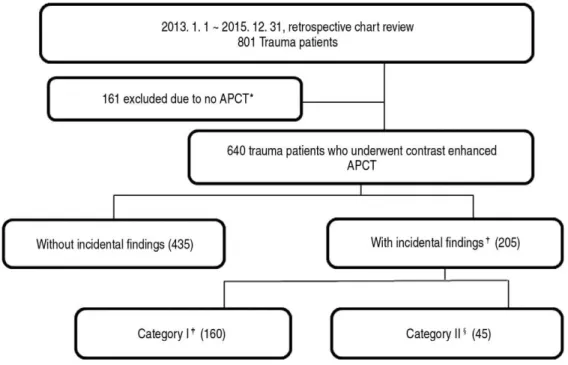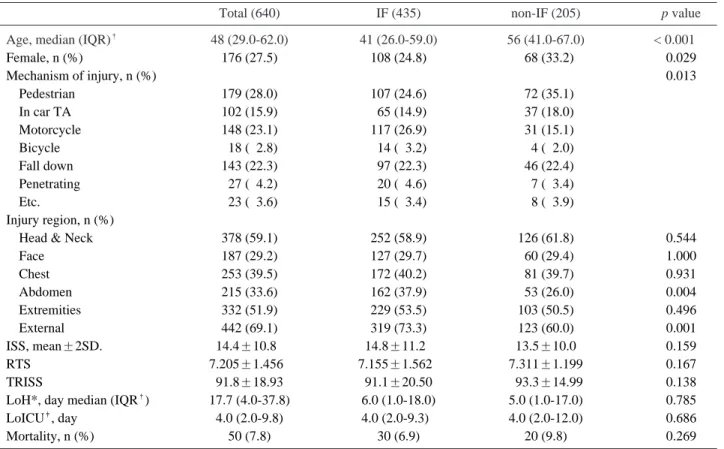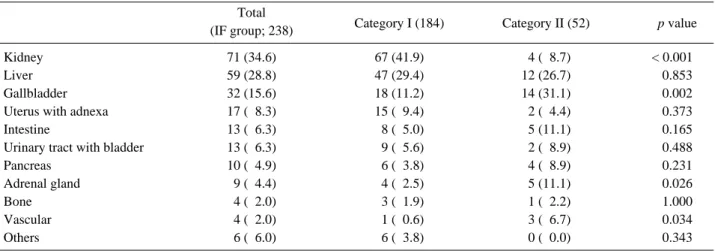Vol. 29, No. 3, September, 2016 http://dx.doi.org/10.20408/jti.2016.29.3.61
� Address for Correspondence : Seung Hwan Lee, M.D.
Department of Surgery, Yonsei University College of Medicine, 50-1 Yonsei-ro, Seodaemun-gu, Seoul 03722, Korea
Tel : 82-2-2228-2108, Fax : 82-2-313-8289, E-mail : seunghwan@yuhs.ac
Submitted : July 7, 2016 Revised : July 13, 2016 Accepted : September 12, 2016 This study was not funded and the authors have no potential conflict of interest to declare.
Prevalences of Incidental Findings in Trauma Patients by Abdominal and Pelvic Computed Tomography
Jin Young Lee, M.D., Myung Jae Jung, M.D., Jae Gil Lee, M.D., Ph.D., Seung Hwan Lee, M.D.
Department of Surgery, Yonsei University College of Medicine, Seoul, Korea
Purpose: Abdominal and pelvic computed tomography (APCT) is frequently used as a diagnostic tool in trauma patients. However, trauma unrelated, incidental findings are frequently encountered. The aim of this study was to determine the prevalences of incidental findings on APCT scans in trauma patients.
Methods: The archived records of 801 trauma patients treated from January 2013 to December 2015 were reviewed retrospectively. Six hundred and forty of these patients underwent contrast enhanced APCT in an emergency depart- ment and were included in this study, and 205 (32.1%) of these patients had incidental findings. These findings were divided into two categories: category I, meaning a radiological benign finding not requiring further evaluation or fol- low-up, and category II, requiring further evaluation and follow-up.
Results: One hundred and sixty (24.8%) patients were allocated to category I and 45 (7.2%) to category II. The most frequent incidental findings were discovered in kidneys (34.6%), followed by liver (28.8%), and gallbladder (15.6%).
The most frequent finding in category I was a benign cyst (60.1%), followed by a simple stone (15.6%), and heman- gioma (11.9%). Adenomyomatosis of the gallbladder (17.8%) was the most common lesion in category II, followed by atypical mass (15.6%), complicated stone (15.6%) and cystic neoplasm (15.6%).
Conclusion: The prevalence of an incidental finding on APCT scans was 32.1%. Although category II lesions were not common in trauma patients, these findings should be communicated to patients, and when necessary referred to a pri- mary care physician. Systems are required for producing appropriate discharge summaries and informing patients about the implications of incidental findings. [ J Trauma Inj 2016; 29: 61-67 ]
Key Words: Incidental findings, Trauma, Abdominal and pelvic computed tomography (APCT)
I. Introduction
The first commercially viable computed tomogra- phy (CT) scanner was installed in Atkinson Morley Hospital in Wimbledon, England in 1971,(1) and since CT technology has vastly improved in speed, slice count, and image quality. Multidetector CT (MDCT) is able to decrease scan times to less than a minute, and obtain high quality images that of less than 1 mm slices.(2) Due to these benefits, CT has become the
preferred means for the initial evaluation of trauma patients.(3-5)
The increased use of CT has not only improved the
immediate diagnosis of injury, but it has also
increased detection of incidental findings (IFs).(6-9)
These IFs may be beneficial to patients, for example,
they may result in the early detection of a significant
pathology, but they also increase anxiety and health-
care costs because of additional investigations under-
taken.(10) Many reports have been issued regarding
the clinical implications of IFs in non-trauma patients,(11-13) and the presence of incidental CT findings in trauma patients has been documented on several occasions.(6-9,14-16) Furthermore, the need for further diagnostic work-up, referral, and treat- ment is difficult for trauma surgeons to deter- mine,(15) and may have serious consequences.
Currently, the work-up of IFs varies between clini- cians and regions, and no well-established classifica- tion exists.(6,7,17)
We performed this study to document the fre- quency of IF detection by abdominal and pelvic computed tomography (APCT) and to determine how many follow-ups were performed in these patients.
II. Materials and Methods
1. Study design and population
This retrospective observational study was con- ducted at a single center from January 2013 to December 2015. During this period 801 trauma patients were admitted to emergency department. Six hun- dred and forty of these patients that underwent
APCT were enrolled in the present study, and divid- ed into two groups: the group with IFs (the IF group; n=205) and the group without IFs (the non- IF group; n=435). The IF group was subdivided into category I (finding not followed; n=160) and category II (finding followed; n=45) (Fig. 1).
A trauma surgeon determined whether a CT scan was required after the patient had undergone an initial primary survey. CT images were immediately reviewed by a senior resident radiologist, and a final reading was subsequently issued by the staff radiol- ogist several days later.
The study was approved by our Institutional Review Board (IRB No. 4-2016-0293), which waived the requirement for informed consent because of the retrospective nature of the study.
2. Variables and definitions
The baseline characteristics included were; age, sex, hospital stay, intensive care unit (ICU) stay, trauma related variables, such as, injury mechanism, injury region, injury severity score (ISS), revised trauma score (RTS), trauma and injury severity score (TRISS),
Fig. 1. Study protocol.
Fig. 1. * APCT: Abdominal and pelvic computed tomography
Fig. 1.
�Incidental findings: findings on APCT unrelated to the injury identified by formal radiologic reading Fig. 1.
�Category I: radiologically benign - no need for further evaluation or follow-up
Fig. 1.
§Category II: requiring further evaluation and follow-up
and mortality.
IFs were defined as findings on APCT, confirmed by formal reading, are unrelated to traumatic injury.
Using previously described classifications,(6,7,15,18) IFs were classified into two categories. Category I was defined as radiological benign requiring no further evaluation or follow-up, e.g., a simple cyst or tiny simple stone, and category II defined a pathology con- cern, such as, adrenal adenoma or a large (>2 cm) or impacted stones, requiring further evaluation, follow- up, and treatment. One investigator independently categorized incidental findings according to these def- initions, and then another investigator confirmed these assignments. Disagreements were discussed and resolved by consensus with other investigators.
3. Statistical analysis
Statistical analysis was performed using IBM SPSS Statistics ver. 20.0 (IBM Co. Armonk, NY). The
baseline and clinical characteristics of patients in the IF and non-IF groups were compared by uni- variate analysis. The anatomical distributions and subgroups of IFs were compared using numbers of IFs and not patient numbers. Categorical data are presented as numbers (%) and were compared using the Chi-square or Fisher’ s exact test. Continuous variables are expressed as means and standard deviations or medians and inter-quantile ranges (IQR), and intergroup comparisons were conducted using the Student’ s t-test or the Mann-Whiney U test. Statistical significance was accepted for p value<0.05.
III. Results
Median age of the 640 study subjects was 48 years, and 27% were women. Median age in the IF group was significantly greater than in the non-IF group (56 vs. 41 years), and the proportion of women
Table 1. Baseline characteristics of all study subjects and of patient groups
Total (640) IF (435) non-IF (205) p value
Age, median (IQR)
�48 (29.0-62.0) 41 (26.0-59.0) 56 (41.0-67.0) < 0.00100
Female, n (%) 176 (27.5) 108 (24.8) 068 (33.2) 0.029
Mechanism of injury, n (%) 0.013
Pedestrian 179 (28.0) 107 (24.6) 072 (35.1)
In car TA 102 (15.9) 065 (14.9) 037 (18.0)
Motorcycle 148 (23.1) 117 (26.9) 031 (15.1)
Bicycle 018 (02.8) 014 (03.2) 004 (02.0)
Fall down 143 (22.3) 097 (22.3) 046 (22.4)
Penetrating 027 (04.2) 020 (04.6) 007 (03.4)
Etc. 023 (03.6) 015 (03.4) 008 (03.9)
Injury region, n (%)
Head & Neck 378 (59.1) 252 (58.9) 126 (61.8) 0.544
Face 187 (29.2) 127 (29.7) 060 (29.4) 1.000
Chest 253 (39.5) 172 (40.2) 081 (39.7) 0.931
Abdomen 215 (33.6) 162 (37.9) 053 (26.0) 0.004
Extremities 332 (51.9) 229 (53.5) 103 (50.5) 0.496
External 442 (69.1) 319 (73.3) 123 (60.0) 0.001
ISS, mean±2SD. 14.4±10.80 14.8±11.20 13.5±10.0 0.159
RTS 7.205±1.4560 7.155±1.5620 7.311±1.199 0.167
TRISS 91.8±18.93 91.1±20.50 093.3±14.99 0.138
LoH*, day median (IQR
�) 17.7 (4.0-37.8) 6.0 (1.0-18.0) 5.0 (1.0-17.0) 0.785
LoICU
�, day 4.0 (2.0-9.8) 4.0 (2.0-9.3)0 4.0 (2.0-12.0) 0.686
Mortality, n (%) 50 (7.8) 30 (6.9) 20 (9.8) 0.269
* LoH: Length of hospital stay
�
IQR: Inter-quartile range
�
LoICU: Length of intensive care unit stay
was significant higher in the IF group (33.2% vs.
24.8%, respectively). Trauma related variables, length of hospital stays and mortalities were not significantly different between these two groups (Table 1). No significant differences were observed
between the baseline characteristics of categories I and II (Table 2).
IFs were most frequently discovered in kidneys (34.6%), followed by liver (28.8%), and gallbladder (15.6%). Similarly, kidneys (41.9%) were most fre-
Table 2. Comparison of baseline characteristics of patients with category I and II
Category I (160) Category II (45) p value
Age, median (IQR)
�56 (42-67) 55 (41-68) 0.951
Female, n (%) 54 (34.0) 14 (30.4) 0.724
Mechanism of injury, n (%) 0.621
Pedestrian 56 (35.2) 16 (34.8)
In car TA 26 (16.4) 11 (23.9)
Motorcycle 26 (16.4) 05 (10.9)
Bicycle 04 (02.5) 00 (00.0)
Fall down 37 (23.3) 09 (19.6)
Penetrating 05 (03.1) 02 (04.3)
Etc. 05 (03.1) 03 (06.5)
Injury region, n (%)
Head & Neck 98 (61.6) 28 (62.2) 1.000
Face 45 (28.3) 15 (33.3) 0.579
Chest 61 (38.4) 20 (44.4) 0.493
Abdomen 41 (25.8) 12 (26.7) 1.000
Extremities 80 (50.3) 23 (51.1) 1.000
External 94 (59.1) 29 (63.0) 0.733
ISS, mean±2SD 13.3±9.50 14.5±11.60 0.480
RTS 7.379±0.977 7.076±1.7600 0.269
TRISS 094.7±11.00 88.4±23.70 0.086
LoH, median (IQR) 5.3 (1.0-16.8) 5.0 (1.8-18.5) 0.858
LoICU 4.0 (2.0-14.0) 2.5 (2.0-7.5)0 0.202
Mortality, n (%) 13 (08.2) 7 (15.2). 0.165
Follow-up, n (%) 9 (23.0)
§�
IQR: Inter-quartile range
§



